Eliot Coleman, a pioneer of four-season gardening, wrote that “gardeners should dedicate a monument to the cold frame.” I agree.
If you can’t wait to start growing in the spring but the weather has other ideas, a cold frame is your secret weapon.
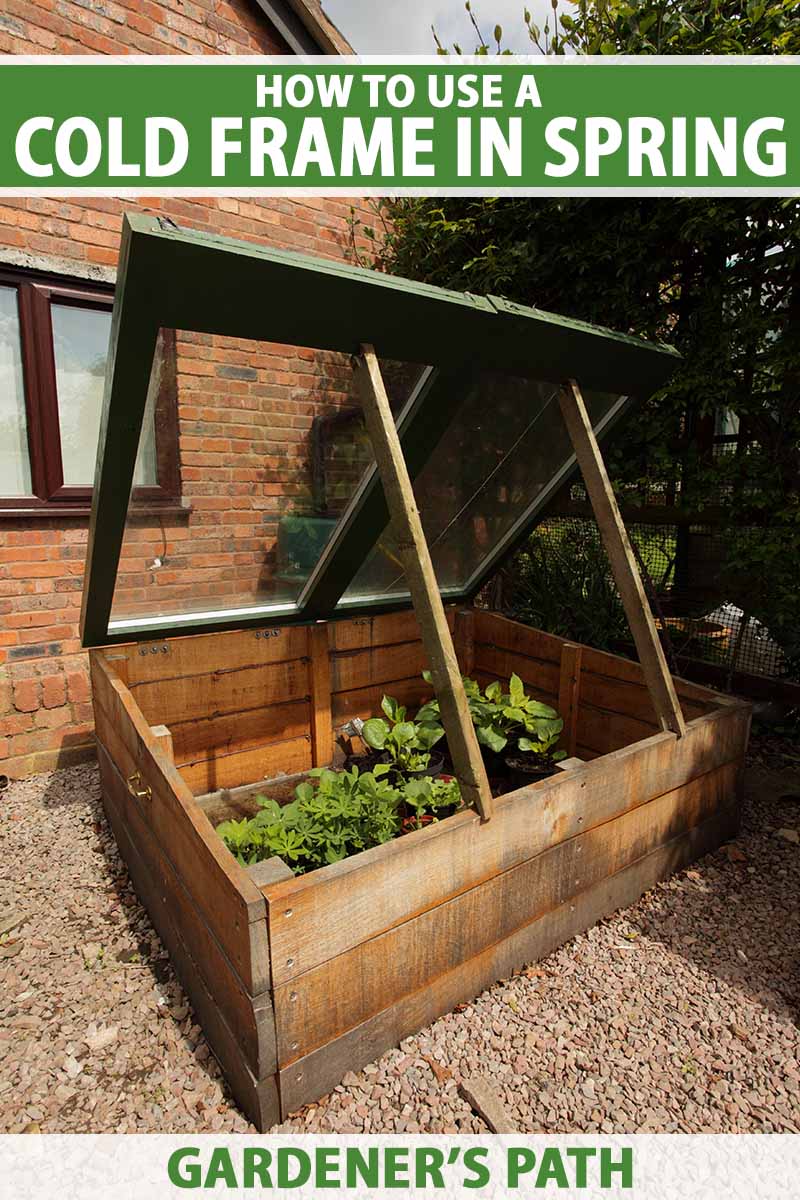
We link to vendors to help you find relevant products. If you buy from one of our links, we may earn a commission.
In my area, the typical spring planting date is in the last week of April. But with this handy tool, I’m starting seeds in early March.
Actually, there are some cold-weather-loving crops I grow year round, but I can start just about anything a few weeks early in the spring – even tomatoes and peppers!
A cold frame is indispensable for hardening off plants that you’ve started indoors and for protecting tender crops during a surprise storm.
You can use yours to propagate seeds or to grow plants that can tolerate cooler temperatures.
And using a cold frame in the spring differs from using one in the fall or winter. It’s really the best time of year for using this indispensable “magic box.”
If you’re thinking of putting this tool to work in your garden, here’s what we’re going to talk about to help you make the most of it:
What You’ll Learn
Can’t wait to start? I get it.
After a long winter, there’s nothing more exciting for a garden lover than starting up those seeds, which bring the promise of warmer weather and abundant harvests.
So let’s go!
How Do Cold Frames Work?
If you’ve never seen a cold frame before, it’s basically a box with an open bottom and a clear material over the top.
It is a bit like a tiny greenhouse, creating a warmer microclimate inside than the general surrounding climate.

A well-situated and insulated structure can raise the temperature by as much as 20°F compared to the outside temperature.
Most raise the temperature between 7 and 10°F – which is still a significant amount!
This structure also protects plants from the damaging effects of drying and rehydrating repeatedly as the spring weather shifts between wet, dry, hot, and cold. It protects plants from frost and chilling winds.
Some gardeners use their frame to create a hotbed, which raises temperatures even higher. We have a guide to creating a hotbed if that interests you.
Finding the Perfect Location
It’s all about location when it comes to making a cold frame effective.
The perfect spot would be on a slight hill that faces south without any obstructions to the east or west, and a building or windbreak to the north.
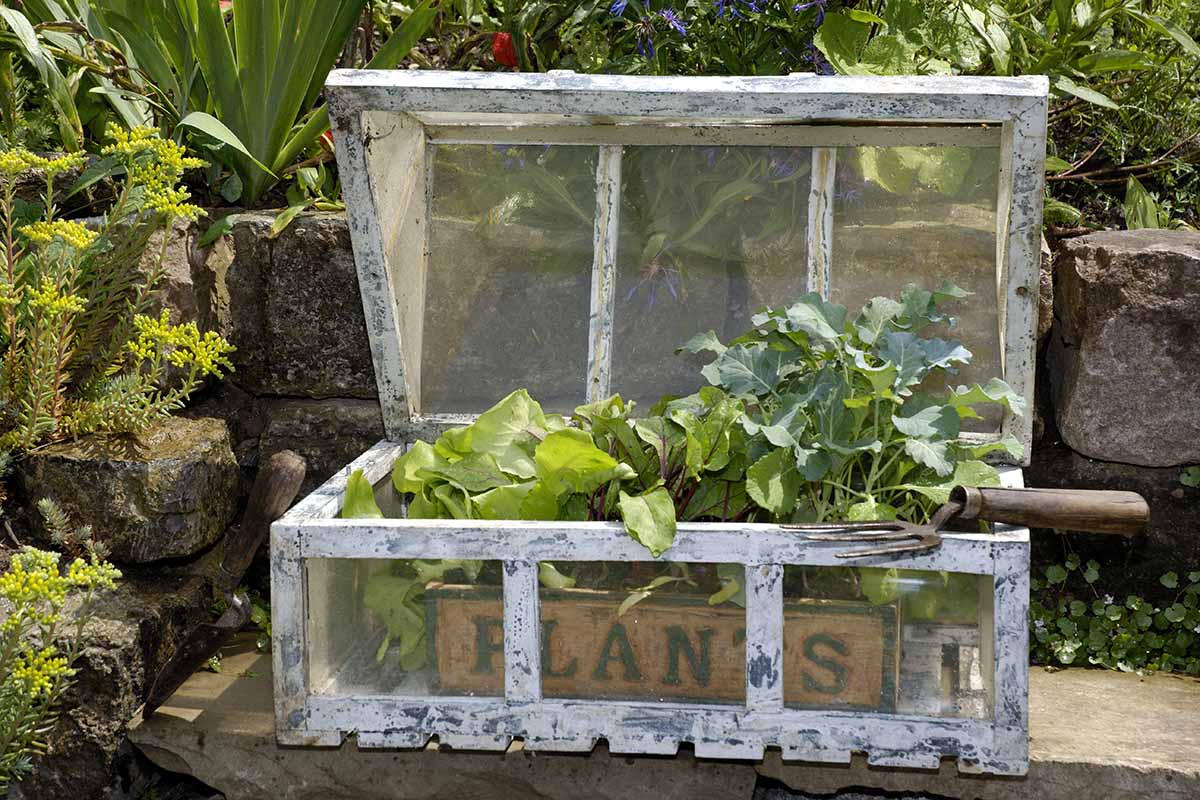
Heap soil, straw, or some other form of insulation on the north, east, and west sides. Or, even better, situate the structure next to a brick wall.
This can increase the temperature inside even more dramatically. The heat from the sun that’s absorbed by the bricks will be released slowly over the course of the day.
Once you’ve situated your cold frame, it’s time to decide how to use it. There are multiple ways, including growing plants that love the cold, protecting frost-tender plants, and starting seeds.
Growing Cold-Loving Plants
Any species that you grow in the spring can be started a bit earlier in a cold frame.
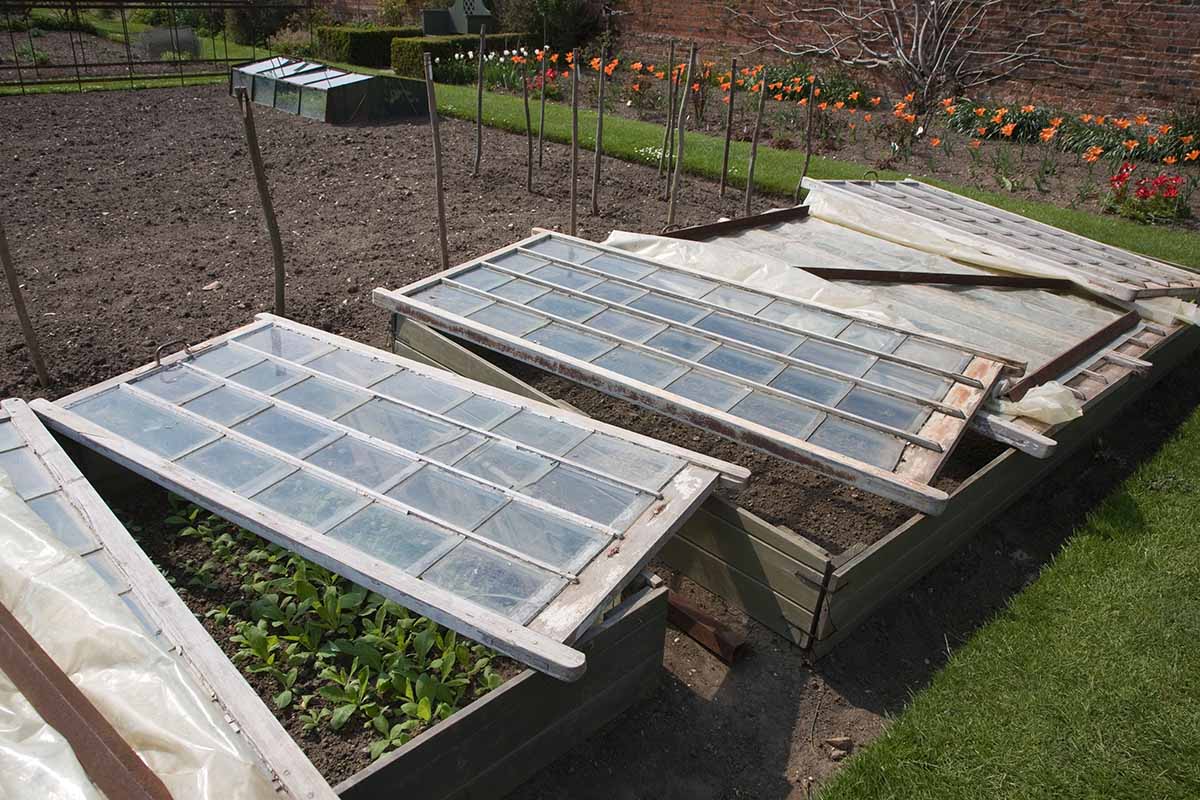
Try plants in the Apiaceae family, which includes carrots, celery, chervil, parsley, parsnips, and skirret.
All those lovely Asteraceae plants like chicory, endive, dandelions, lettuce, radicchio, and salsify are good candidates, too.
Of course, the Brassicaceae family, which includes arugula, broccoli, cabbage, kale, kohlrabi, mizuna, radishes, and tatsoi, are classic cool-weather options.
Various cold-tolerant plants from other families can also work nicely.
Don’t forget about beets, spinach, Swiss chard, peas, leeks, strawberries, green onions, sorrel, claytonia, purslane, and greens like mache as well.
Gardeners in Zone 7 and up can grow most of these all year long in a cold frame. For those in colder regions, you can start these in your structure up to a month early.
Open up the frame when the weather’s balmy to air the interior out and keep the environment from becoming too humid, which can create the perfect breeding ground for disease.
Hardening Off Tender Plants
Frost-tender plants like beans, tomatoes, melons, chilis, squash, and basil are popular spring options, but they can’t usually be put outside until well after the risk of frost has passed.
For those with a short growing season, that presents a serious problem. It’s hard to grow a chili that needs 150 days to mature if your typical frost-free growing season is only 120 days long.
Cold frames can extend your growing season by weeks, giving you the time you need to let your plants mature.
When you harden plants off, you aren’t leaving them in the structure permanently. It’s just a temporary stop on the way to life in the great outdoors.
You’ll start your seeds indoors and let them mature for a bit before you bring them outside.
Determining how long a plant needs to mature depends on what you’re growing, but the gist is that the seedlings should be about to the point where you’d put them outside normally.
That means you’ll need to start the whole process well in advance of when you normally would. As a general rule of thumb, start a month sooner than usual.
But instead of plopping your starts in the ground, you can put the containers in the cold frame first.
If needed, you can cover the cold frame with a blanket to protect the plants from getting too much sun during the hottest parts of the day, and you can open the lid during periods of good weather.
Once the threat of frost has passed, go ahead and transplant your starts into their permanent spots in the ground.
Starting Seeds
If you don’t have a good spot for starting seeds indoors, or you just want to keep the mess outside, you can also start seeds right in your cold frame.
You can do this at any time of year, but the spring is particularly perfect.

Don’t try to start seeds that need warm soil temperatures to germinate. Chilis, tomatoes, basil, and other heat-loving plants won’t germinate until the ground is warm.
But seeds that don’t mind a chilly environment will start perfectly well in a frame before the last predicted frost date.
Remember, the soil temperature in your frame is likely about 10 degrees higher than that in the outside environment.
So a seed that requires 45°F minimum to germinate can be started in the cold frame even when the outside soil temperature is only 35°F.
You’ll want to use seed-starting trays or pots so you can move your seedlings out of the cold frame and into the soil when the time comes.
Caring for Your Plants
Of course, the specific care your plants require is going to depend on the individual species, but there are some general guidelines you can follow to care for plants in a cold frame.
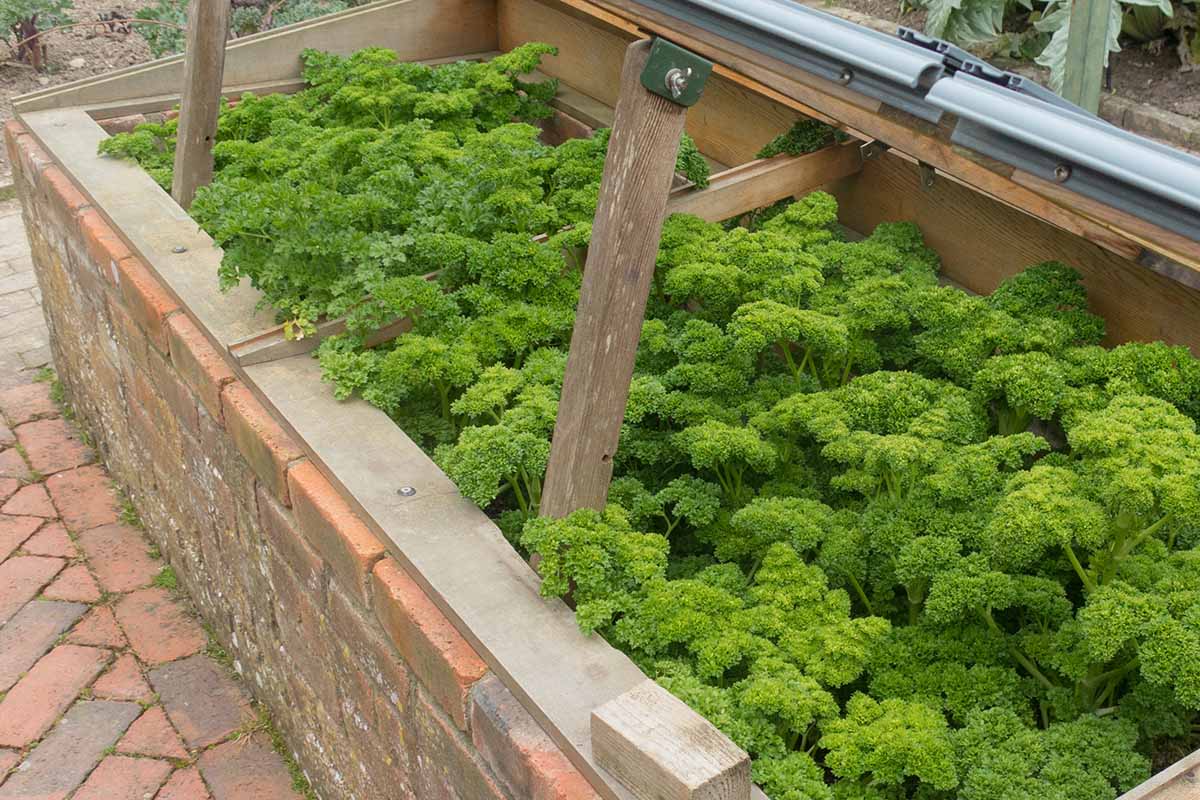
First, be mindful of humidity. It can become extremely humid inside that box, which can be a good or bad thing, depending on the species.
When possible, prop open the lid to let some of the humidity out.
The same goes for water. The soil in a cold frame tends to hold onto more water because it isn’t subject to the drying effects of wind. Be careful not to overwater your plants.
Keep a super close eye out for damping off, wilting, yellowing leaves, fungal spores, or other signs of disease.
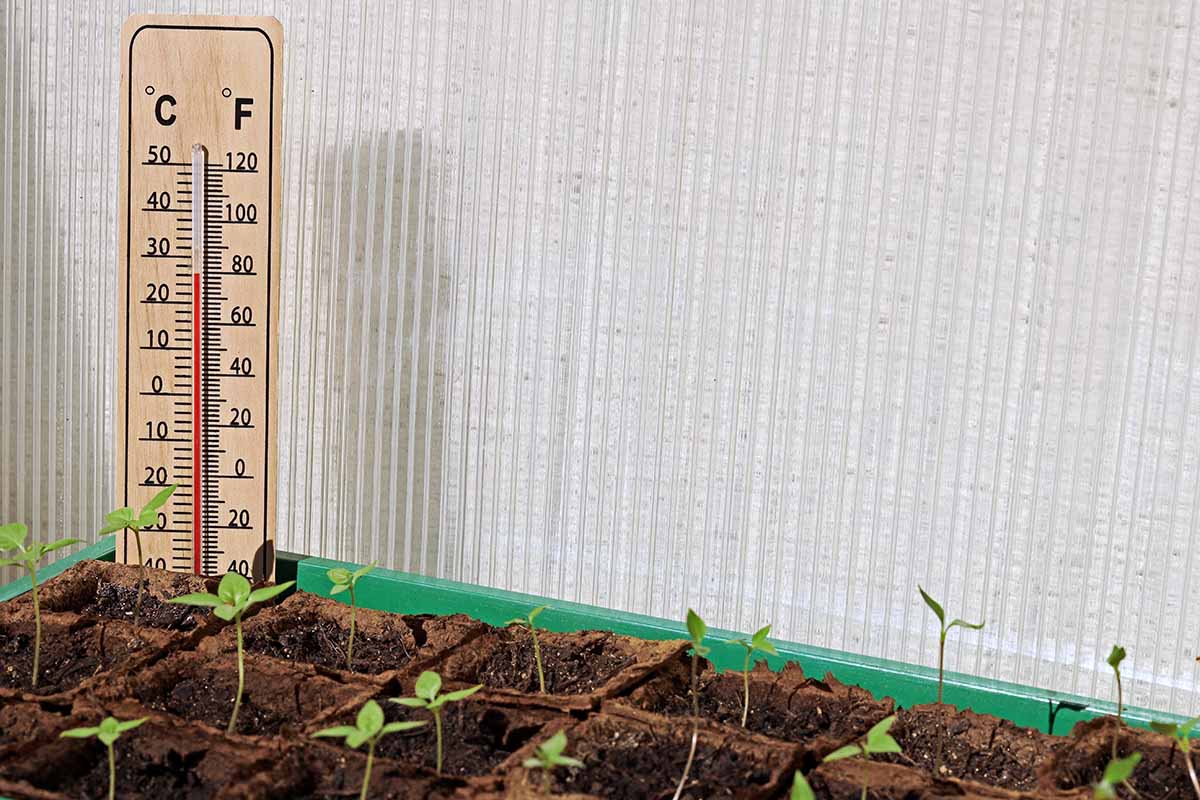
Spring can be a strange time of year. One day it’s freezing and the next day it’s boiling hot. On those super warm days, be sure to open up the lid. It can quickly turn into an oven inside.
It can help to keep a thermometer in your frame to help you keep an eye on the temperature.
Put the “Magic Box” to Work in the Spring
Cold frames are so cool. When everyone else is champing at the bit in the spring to get their garden started, you can be weeks into growing.
Any seeds you start indoors can have a huge head start.

Combined with using your cold frame in the fall, you can truly extend your growing season by at least two months.
May through September and that’s it? Not for you. You’ll be able to raise plants from April through October.
What will you cultivate in your cold frame? Tell us all about it in the comments.
If you’re curious about more ways to extend the growing season, we have lots of guides to help you on your way. Consider checking out the following next: